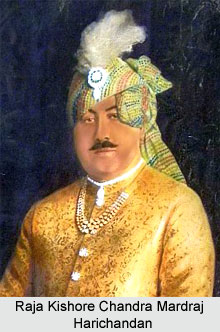 The Princely State of Nilgiri, also known as Nilagiri, was one of the well known princely states of India that was administered by a native prince under the guidance of the British authorities. The princely state was under the indirect control of the British Empire in India. The former native state of Nilgiri was headquartered at Raj Nilgiri, which was presently located in the modern town of Nilagiri. The region covered a total area of 284 sq miles and comprised of a total population of 73,109 in the year 1941. The state was bounded by the region of Mayurbhanj in the west; and by the British district of Balasore (Province of Orissa) in the east. The erstwhile state included around 466 villages in 1911. It was incorporated as a part of Orissa States Agency, which was a sub division of Eastern States Agency.
The Princely State of Nilgiri, also known as Nilagiri, was one of the well known princely states of India that was administered by a native prince under the guidance of the British authorities. The princely state was under the indirect control of the British Empire in India. The former native state of Nilgiri was headquartered at Raj Nilgiri, which was presently located in the modern town of Nilagiri. The region covered a total area of 284 sq miles and comprised of a total population of 73,109 in the year 1941. The state was bounded by the region of Mayurbhanj in the west; and by the British district of Balasore (Province of Orissa) in the east. The erstwhile state included around 466 villages in 1911. It was incorporated as a part of Orissa States Agency, which was a sub division of Eastern States Agency.
History of Princely State of Nilgiri
The Princely State of Nilgiri was administered by the native ruler, who accepted the suzerainty of the British Government of India in return of protection from outside sources. The sovereign of Nilgiri managed the internal affairs of the region; where as the British political agent, also known as Resident of British India, maintained then associations of the state with the British administration and other territories. The native ruler of Nilgiri state, who held the title of Raja, exercised the powers and authority of a ruling chief. The state was segmented into chaklas; a sabarkar in each chakla was responsible for law and order, revenue collection, mandatory services and various other functions. The princely states of Nilgiri and Mayurbhanj were the only Eastern States that allowed a modicum of civil liberties. Nilgiri was one of the original constituent members of the Chamber of Princes, a number of smaller states indirectly represented by 12 princes who were elected periodically.
Several freedom fighters of India such as Nanda Kishore Patnaik, Baishnab Patnaik and Banamali Das aggressively fought against the native prince and compelled him to surrender. Thus after the Indin independence in the year 1947, he acceded his state to the newly formed Union of India and the Indian National Government. Later in the year 1949, the region was incorporated as a part of the district of Balasore.
At present, Nilgiri or Nilagiri is a notified area committee and a town in the Balasore district, also known as Baleshwar or Baleswar District, located in the eastern Indian state of Orissa.
Rulers of Princely State of Nilgiri
The chronology of the native rulers of the princely state of Nilagiri or Nilgiri, who held the title of Raja, is mentioned below-
* Raja Narayan Singh Bhujang Mandhata Birat Basant Harichandan (1521- 1564)
* Raja Ram Chandra Mardraj Harichandan (1797- 1832)
* Raja Govind Chandra Mardraj Harichandan (1832- 1833)
* Rani Chira Devi (1833- 1843)
* Raja Krishna Chandra Mardraj Harichandan (1843- 1893)
* Raja Shyam Chandra Mardraj Harichandan (1893- 1913)
* Raja Kishore Chandra Mardraj Harichandan (1913- 1960)
* Raja Rajendra Chandra Mardraj Harichandan (1960- 1948)



















